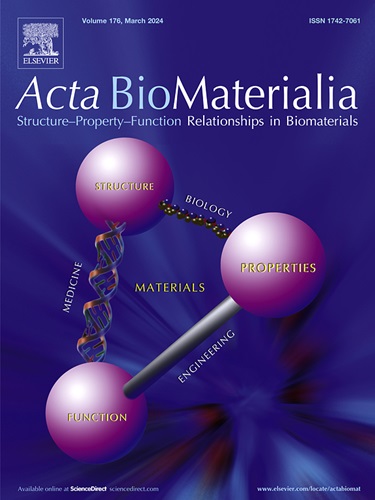Signs of in-vivo aging of zirconia from explanted dental implants with porous coating after several years in function
IF 9.4
1区 医学
Q1 ENGINEERING, BIOMEDICAL
引用次数: 0
Abstract
The present study investigated the in vivo aging of yttria-stabilized zirconia (YSZ) oral implants (ZiUnite®) removed after 37 to 181 months. These implants featured a porous zirconia surface to enhance osseointegration. They were placed in prospective clinical investigations and had to be explanted due to peri‑implant bone breakdown. Since no single clinical/non-clinical parameter or combination of parameters were found to influence the bone loss, we have assessed the extent of the in vivo aging, known as low temperature degradation (LTD), on five explants as a possible critical influencing parameter. This research represents, to the best of our knowledge, the first report on low-temperature degradation-induced tetragonal-to-monoclinic (t-m) transformation in clinically applied YSZ oral implants after up to 15 years.
Using scanning electron microscopy (SEM) and focused ion beam (FIB)-SEM tomography, the analysis revealed significant surface t-m transformation, pronounced micro-cracking of the porous coating, and degradation. This extensive transformation and resultant volume expansion may have negatively impacted the bone-to-implant interface, contributing to clinical failure. Additionally, differently produced YSZ implants can exhibit varied behaviors, even with identical raw materials. The presented type of assessment of susceptibility to in vivo aging of oral implants could inspire the study protocol for other medical device systems.
Statement of significance
This study is the first to document substantial t-m transformation of clinically used YSZ implants after up to 15 years in the oral environment. Extensive t-m transformation in the porous coatings at body temperature occurred rapidly, leading to microcracking and potential loss of cohesion with the implant bulk. The porous, cracked zirconia coatings were linked to brittle fractures in vivo and it is hypothesized that these changes possibly contributed to bone loss, loss of osseointegration and subsequent implant failures. The findings of such transformation underscore the potential clinical risks of these zirconia coatings leading to the mentioned changes. The present assessment method could serve as a valuable protocol model for investigating the in vivo aging susceptibility of other medical devices.

具有多孔涂层的牙种植体在功能几年后体内氧化锆老化的迹象。
本研究研究了去除ytria -稳定氧化锆(YSZ)口腔种植体(ZiUnite®)37至181个月后的体内老化情况。这些种植体具有多孔氧化锆表面以增强骨整合。他们被放置在前瞻性临床调查中,由于种植体周围的骨破坏而不得不被移出。由于没有发现单个临床/非临床参数或参数组合影响骨质流失,我们评估了五种外植体的体内老化程度,即低温降解(LTD),作为可能的关键影响参数。据我们所知,这项研究是在长达15年后首次报道低温降解诱导的YSZ口腔种植体向单斜(t-m)转化。通过扫描电子显微镜(SEM)和聚焦离子束(FIB)-SEM断层扫描,分析发现表面t-m转变明显,多孔涂层有明显的微开裂和降解。这种广泛的转化和由此产生的体积膨胀可能对骨-种植体界面产生负面影响,导致临床失败。此外,即使使用相同的原材料,不同生产的YSZ植入物也会表现出不同的行为。本文提出的口腔植入物体内老化敏感性评估方法可以启发其他医疗器械系统的研究方案。意义声明:这项研究首次记录了临床使用的YSZ种植体在口腔环境中长达15年后的t-m转化。多孔涂层在体温下迅速发生广泛的t-m转变,导致微开裂,并可能失去与植入体的内聚性。多孔、破裂的氧化锆涂层与体内脆性骨折有关,假设这些变化可能导致骨丢失、骨整合丧失和随后的种植失败。这种转变的发现强调了这些氧化锆涂层导致上述变化的潜在临床风险。该评估方法可作为研究其他医疗器械体内老化易感性的有价值的方案模型。
本文章由计算机程序翻译,如有差异,请以英文原文为准。
求助全文
约1分钟内获得全文
求助全文
来源期刊

Acta Biomaterialia
工程技术-材料科学:生物材料
CiteScore
16.80
自引率
3.10%
发文量
776
审稿时长
30 days
期刊介绍:
Acta Biomaterialia is a monthly peer-reviewed scientific journal published by Elsevier. The journal was established in January 2005. The editor-in-chief is W.R. Wagner (University of Pittsburgh). The journal covers research in biomaterials science, including the interrelationship of biomaterial structure and function from macroscale to nanoscale. Topical coverage includes biomedical and biocompatible materials.
 求助内容:
求助内容: 应助结果提醒方式:
应助结果提醒方式:


